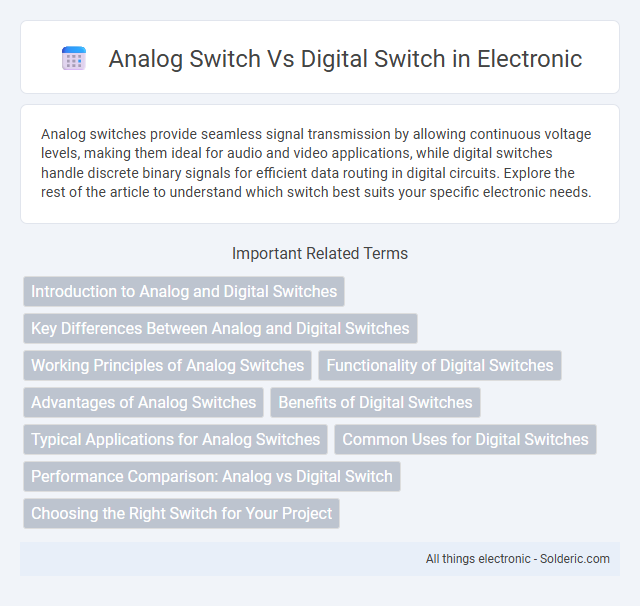Analog switches provide seamless signal transmission by allowing continuous voltage levels, making them ideal for audio and video applications, while digital switches handle discrete binary signals for efficient data routing in digital circuits. Explore the rest of the article to understand which switch best suits your specific electronic needs.
Comparison Table
| Feature | Analog Switch | Digital Switch |
|---|---|---|
| Function | Passes continuous analog signals | Transfers digital signals (0s and 1s) |
| Signal Type | Analog (continuous voltage or current) | Digital (discrete voltage levels) |
| Applications | Audio, video, sensor inputs | Logic circuits, microcontrollers, digital systems |
| Switching Speed | Moderate, depends on technology | High, optimized for rapid state changes |
| Control Signal | Typically digital control input | Digital control signal |
| On-Resistance | Low but varies with voltage | Typically very low with fast transitions |
| Power Consumption | Low to moderate | Very low, ideal for low-power circuits |
| Examples | 4066, CD4016 analog switches | 74HC series, TTL logic switches |
Introduction to Analog and Digital Switches
Analog switches control continuous electrical signals, allowing seamless passage or interruption of analog voltages without altering signal integrity. Digital switches, by contrast, manage discrete binary signals, turning circuits on or off based on digital logic levels. Your choice between analog and digital switches depends on whether precise signal replication or binary control is required for your application.
Key Differences Between Analog and Digital Switches
Analog switches transmit continuous voltage levels, allowing seamless signal flow for audio and video applications, while digital switches operate on discrete binary signals, enabling precise on/off control in digital circuits. Your choice depends on signal type and application requirements, with analog switches favoring smooth transitions and digital switches providing fast, noise-resistant switching. Key differences include analog switches' variable signal handling versus digital switches' binary operation, impacting speed, accuracy, and signal integrity.
Working Principles of Analog Switches
Analog switches operate by using semiconductor devices, such as MOSFETs, to control the flow of analog signals through a circuit, enabling the continuous passage of voltage or current with minimal distortion. These switches maintain signal integrity by allowing analog signals to pass in either direction when the control input is activated, effectively acting as voltage-controlled resistors. Understanding the working principles of analog switches can help optimize Your circuit design for applications requiring precise signal routing and low-noise performance.
Functionality of Digital Switches
Digital switches function by controlling binary signals, allowing precise on/off states to manage electronic circuits effectively. They enable the routing of digital data, ensuring high-speed switching with minimal signal distortion and low power consumption. Unlike analog switches, digital switches operate with discrete levels, making them essential for logic circuits, microprocessors, and digital communication systems.
Advantages of Analog Switches
Analog switches offer superior signal integrity by providing low distortion and minimal on-resistance, which preserves the original waveform in audio and sensor applications. They handle a continuous range of voltages, making them ideal for analog signal routing without converting signals to digital form. Your designs benefit from their simplicity, low power consumption, and excellent linearity, especially in applications requiring high-fidelity analog signal processing.
Benefits of Digital Switches
Digital switches offer precise and rapid signal control with minimal noise interference, enhancing overall system performance in electronic circuits. They provide greater reliability and longevity due to fewer moving parts compared to analog switches, reducing maintenance needs. You can benefit from their compatibility with digital systems, enabling seamless integration into modern automated and programmable environments.
Typical Applications for Analog Switches
Analog switches are commonly used in signal routing, audio and video equipment, and data acquisition systems due to their ability to handle continuous voltage signals with low distortion. They excel in applications like multiplexers, sample-and-hold circuits, and sensor interfacing where analog signal integrity is critical. Unlike digital switches, analog switches maintain signal analog characteristics, making them ideal for precision analog circuits and instrumentation.
Common Uses for Digital Switches
Digital switches are widely used in electronic devices for controlling circuits through binary signals, making them essential in applications like microcontrollers, logic gates, and memory devices. They are integral in data routing, signal processing, and communication systems where precise on/off control is required. The reliability and speed of digital switches make them preferred components in automation, computing, and embedded systems.
Performance Comparison: Analog vs Digital Switch
Analog switches provide seamless signal transmission with minimal distortion and noise, making them ideal for audio and video applications requiring high fidelity. Digital switches excel in precision and speed, offering rapid switching times and low power consumption suitable for logic circuits and digital signal routing. Performance depends on application context, where analog switches prioritize signal integrity and digital switches emphasize switching efficiency.
Choosing the Right Switch for Your Project
Choosing the right switch for your project depends on signal type and control requirements; analog switches efficiently route continuous signals with minimal distortion, while digital switches excel in handling discrete logic levels with fast switching speeds. Consider factors like signal bandwidth, on-resistance, and leakage current for analog switches, whereas digital switches demand precise voltage thresholds and timing control. Evaluating these parameters ensures your project's reliability and optimal performance by matching the switch technology to your specific application needs.
analog switch vs digital switch Infographic

 solderic.com
solderic.com